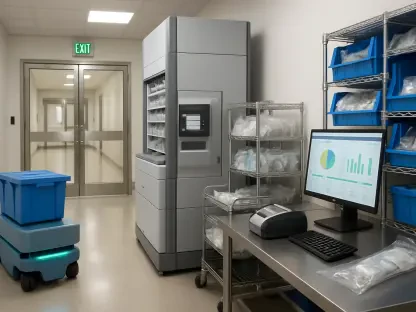The release of the 2024 Healthcare Cybersecurity Survey Report by the Healthcare Information Management Systems Society (HIMSS) has provided a compelling and comprehensive overview of the current state of cybersecurity within the healthcare industry. As cyber threats continue to evolve and grow more sophisticated, healthcare organizations have made significant strides in enhancing their security frameworks. However, these advancements come with their own set of challenges, particularly in the areas of governance and workforce development. The report highlights the dual nature of these strides—significant progress tempered by ongoing vulnerabilities that need to be addressed.
Ensuring the integrity and security of sensitive patient data remains a top priority for the healthcare sector. With technological advancements come new threats, particularly as organizations increasingly rely on interconnected systems and innovative technologies such as artificial intelligence (AI). The HIMSS report underscores the complex landscape that healthcare cybersecurity professionals navigate daily. Their insights and experiences form the backbone of the survey, shedding light on both the strides made and the gaps that still need to be filled to protect against emerging cyber threats.
Developments and Threats
Healthcare organizations have demonstrated notable progress in enhancing their cybersecurity frameworks over the past few years. Advances include the implementation of sophisticated security tools, the adoption of more rigorous cybersecurity policies, and an increased focus on staff training and awareness. However, the introduction and integration of AI technology into healthcare systems have raised new concerns related to data security and privacy. Without adequate governance mechanisms, the risks associated with AI can remain largely unchecked. This lack of oversight can expose organizations to a variety of threats, from insider attacks to vulnerabilities originating from third-party vendors.
One of the key themes emerging from the HIMSS report is the necessity of robust governance mechanisms, especially concerning AI. While financial investments in cybersecurity have helped to bolster overall security postures, these advances are rendered less effective if not complemented by comprehensive governance frameworks. This includes creating clear policies for AI application, managing insider threats, and securing data handled by third-party contractors and suppliers. The absence of stringent governance processes can lead to unchecked risks, which could compromise sensitive patient data and undermine the overall security framework of the organization.
Budget Allocation and Security Investments
A significant finding of the HIMSS survey is the gradual but steady increase in the percentage of overall IT budgets allocated to cybersecurity. This growth—from 10% in 2020 to 14% in 2024—demonstrates a strategic alignment of resources by healthcare organizations to address critical vulnerabilities. These allocations reflect the sector’s recognition of the importance of robust cybersecurity measures in maintaining the integrity of IT infrastructures and safeguarding patient data.
Despite these positive trends, the report highlights that budget increases since 2019 have been relatively modest. This modest growth indicates that while there is a recognition of the need for investment, the financial commitments may not be keeping pace with the growing sophistication and complexity of security threats. The findings suggest that a more substantial increase in resources is necessary for healthcare organizations to effectively combat emerging risks. Additionally, while a slight majority of organizations anticipate increases in their overall IT budgets for 2025, a portion still expects reductions, underscoring the financial balancing act many institutions must perform in prioritizing cybersecurity amid other operational demands.
AI Governance and Emerging Threats
The HIMSS survey identifies a significant gap in the monitoring and governance of AI technologies within healthcare organizations. Nearly half of the respondents reported that their organizations have established approval processes for AI technology implementation, which indicates some level of oversight. However, a significant portion also disclosed a lack of formal governance around AI usage. This absence creates considerable vulnerability, making organizations more susceptible to a range of security threats including data leaks, breaches, and sophisticated AI-driven phishing attacks.
The report highlights machine learning-driven cyber subterfuge as an emerging threat that underscores the urgent need for stringent AI governance frameworks. Without these frameworks, healthcare organizations risk exposing themselves to advanced cyber threats that could compromise patient data and overall system integrity. The rapid development of AI technologies necessitates a proactive approach to governance, ensuring that all applications and uses of AI are rigorously vetted, monitored, and controlled to mitigate potential security risks. Organizations must prioritize formal governance structures to manage these emerging threats effectively.
Workforce and Policy Improvements
Increased cybersecurity budgets have enabled healthcare organizations to make substantial improvements in security tools, policies, and staffing. However, workforce development remains an enduring challenge. The ability to hire, retain, and upskill employees is critical to maintaining a robust cybersecurity framework. Employee retention is particularly challenging in a competitive job market where qualified cybersecurity professionals are in high demand. Limited security budgets have historically stymied efforts to develop a strong cybersecurity workforce, making workforce development a key area requiring consistent attention and investment.
Addressing workforce challenges involves a multi-pronged approach. Education and continuous professional development are essential to ensure that staff are prepared to handle evolving threats. Providing the right tools and creating comprehensive security policies are also crucial to support staff in their roles. Investing in workforce development not only strengthens the organization’s security posture but also empowers employees to be more effective in their roles. Enhanced training and development programs, closer attention to employee engagement and retention, and strategic investment in upskilling initiatives are crucial steps towards building a resilient cybersecurity workforce.
Priority Communication and Engagement
The HIMSS survey draws its insights from 273 healthcare cybersecurity professionals, responsible for overseeing or managing their organization’s cybersecurity programs. These respondents shared their perspectives, knowledge, and experiences from the past year, offering a window into the real-world challenges and achievements in healthcare cybersecurity. One notable observation from the survey is the discrepancy in budget awareness between executive managers and other staff members. While executive managers typically have a clear understanding of cybersecurity budget allocations, other employees often have limited awareness of these critical resource distributions.
This gap in awareness highlights the need for better communication and information sharing about organizational cybersecurity programs. Ensuring that all staff members, regardless of their position, are informed about the organization’s cybersecurity priorities and resource allocations can enhance overall engagement and foster a more inclusive security culture. Transparency in budget and policy decisions can bridge the gap between different tiers of the organization, promoting a unified approach to cybersecurity efforts. It can also help in garnering support and fostering a shared sense of responsibility across the organization.
Engaging the Workforce
The 2024 Healthcare Cybersecurity Survey Report, released by the Healthcare Information Management Systems Society (HIMSS), provides a comprehensive perspective on the current state of cybersecurity in the healthcare sector. As cyber threats continue to evolve and grow more sophisticated, healthcare organizations have significantly improved their security frameworks. However, these advancements bring new challenges, especially in governance and workforce development.
The report highlights this dual nature of progress—marked advancements alongside persistent vulnerabilities that must be addressed. The integrity and security of sensitive patient data remain paramount. With technological progress, new threats emerge, especially as organizations rely more on interconnected systems and advanced technologies like artificial intelligence (AI).
The HIMSS report emphasizes the complex landscape that healthcare cybersecurity professionals navigate daily. Their insights and experiences are central to the survey, illustrating both the progress made and the gaps that remain in mitigating emerging cyber threats.









